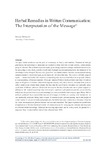Mostrar o rexistro simple do ítem
Herbal remedies in written communication: The interpretation of the message
| dc.contributor.author | Söukand, Renata | es_ES |
| dc.date.accessioned | 2014-10-02T12:31:28Z | |
| dc.date.available | 2014-10-02T12:31:28Z | |
| dc.date.issued | 2012 | es_ES |
| dc.identifier.citation | Culture of communication / Communication of culture, 2012: 459-466. ISBN: 978-84-9749-522-6 | es_ES |
| dc.identifier.isbn | 978-84-9749-522-6 | es_ES |
| dc.identifier.uri | http://hdl.handle.net/2183/13341 | |
| dc.description.abstract | [Abstract] For ages, herbal medicine was the part of community or family oral tradition. Transmitted through generations, the knowledge of medicinal use of plants is often described as kept secretly, within defined group of initiated. The outbreak of printed media gives strong impulse to change traditional transmission: the knowledge is now freely available in all kind of printed sources and presumably the character of the knowledge is also changed. We may only guess how was herbal medical tradition communicated among common people in pre-printed ages, as no traces are left from that time. Not even in old folk songs or myths — seems that herbal folk medicine is something that does not find reflection in general folklore, at least according to Estonian material. Although Estonian Folklore Archives hold more than 1,4 million pages of all genres of folklore collected during last century, only about thirteen thousand short texts on herbal medicine are present there; despite the fact, that the use of herbal remedies was repeatedly asked by all kind of folklore collectors. Reason for that may be the fact, that domestic use of plants required in addition to folk medical knowledge also at least some experience with plants (except the use of officially sold plants, the practice that is common nowadays, but was not available half a century ago). Many folklore archives worldwide have considerable amount of messages on herbal use, waiting to be interpreted, not just statistically analyzed. Being itself a result of communication process (among nature and people or within bearers of culture or media and people etc), the herbal lore once written down becomes a base for the future communication process between the text and researcher. The paper explores the possibilities of application of Roman Jakobson’s model of communication for analyzing the contents and structures of collected herbal knowledge. Although the resulting application can be widely used, the ground for it originates from Estonian herbal medical lore collected since 1888. | es_ES |
| dc.language.iso | eng | es_ES |
| dc.publisher | Universidade da Coruña | es_ES |
| dc.title | Herbal remedies in written communication: The interpretation of the message | es_ES |
| dc.type | info:eu-repo/semantics/conferenceObject | es_ES |
| dc.rights.access | info:eu-repo/semantics/openAccess | es_ES |






